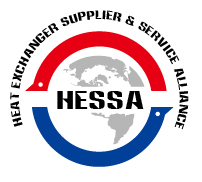BRAZED PLATE HEAT EXCHANGER
INFORMATION SHINEHEAT
BRAZED HEAT EXCHANGERS
Working conditions
SHINEHEAT BRAZED PLATE HEAT EXCHANGER’s are 100% leak and pressure tested and covered by a number of third part approvals. Below table indicates the different pressure and temperature limitations for SHINEHEAT’s copper/nickel/stainless steel brazed BRAZED PLATE HEAT EXCHANGER’s
Performance
SHINEHEAT’s policy is that the calculation and prediction software shall be as accurate as possible with the reality. Calculation correlations (formulas) in are based on real lab tests from SHINEHEAT performance laboratory. SHINEHEAT test all models for one phase applications and specific models for two phase applications. Other allowed input to is confirmed and verified results from third part and customer labs. The performance accuracy of shall be within +/-3% for water to water applications in the turbulent area.
SHINEHEAT work continuously to improve the heat exchange performance of its BRAZED PLATE HEAT EXCHANGER.
Lifetime
The life time of a proper installed BRAZED PLATE HEAT EXCHANGER’s in approved applications can not be set to X years.
In the product development mechanical strength is prioritized along with the heat exchange performance. 3D simulation (CFD) and CAD/CAM tools are used. Narrow tolerances in pressing tools are critical to obtain good mechanical properties of the end product (the BRAZED PLATE HEAT EXCHANGER). All tools (both pressing and cutting) are made in house using high speed milling that can mill direct in hard material and thereby achieve extremely narrow tolerances.
In order to ensure both existing and new models good life time performance all models are heavily tested with regard to mechanical and thermal fatigue. Wöhler curves (that shows the different models fatigue resistant) is available upon request. Further are all models on a monthly basis burst pressured to ensure the consistency of each model’s mechanical properties.
All material used in a BRAZED PLATE HEAT EXCHANGER is covered by material certificates fulfilling the special (additional) material requirements to achieve an outstanding end product (BRAZED PLATE HEAT EXCHANGER).
Production processes (pressing and brazing) are controlled to ensure that the BRAZED PLATE HEAT EXCHANGER’s metallurgical composition (e.g. grain sizes) is ensures a trouble free field operation.
SHINEHEAT warrants all its products for good workmanship and material (standard is 12 months after installation or 18 months after delivery, whichever occurs first).
Quality and quality system
All SHINEHEAT factories are ISO 9001:2000 certified and also use Statistic Process Control (SPC). Each delivered unit is marked with a unique serial number to which each delivered units: material certificates, pressing tools and brazing batch can be traced.
SHINEHEAT BRAZED PLATE HEAT EXCHANGER’s are 100% leak and pressure tested and covered by a number of third part approvals. Leak test is done by helium.
Approval certificates and detailed quality control plans from our ISO 9001:2000 certified quality control system is available upon request.
Storage of Compact Brazed Heat Exchangers (BRAZED PLATE HEAT EXCHANGER’s)
BRAZED PLATE HEAT EXCHANGER’s shall be stored in a clean, dry and weather protected area. The temperature in the stock area should be kept relatively stable avoiding quick temperature fluctuations (normal day and night temperatures are not a problem). It is recommended to keep the storage temperature at max 80 C and min -30 C. BRAZED PLATE HEAT EXCHANGER’s shall be placed so that particles cannot enter the ports at stocking. In cases the BRAZED PLATE HEAT EXCHANGER’s are delivered with protecting plastic caps on the connections these shall not be removed until time of assembly. The BRAZED PLATE HEAT EXCHANGER shall be stored so that it’s protected from mechanical damage. In cases BRAZED PLATE HEAT EXCHANGER’s are stacked upon each other the different layers shall be separated by a bar e.g. a wood or plastic bar so that the layers of BRAZED PLATE HEAT EXCHANGER’s are completely separated BRAZED PLATE HEAT EXCHANGER’s from SHINEHEAT factories are packed in such manner at the arrival to customers. Wood material used from SHINEHEAT can if requested be covered by a fumigation certificate.
Claims
SHINEHEAT’s policy is that all claimed units independent of cause shall be returned to SHINEHEAT for investigation. SHINEHEAT is covering the transport costs assuming that SHINEHEAT forwarding agent is used.
SHINEHEAT has systematically registered all claims since the beginning of the company, since the early 90’s all claims are registered into a large database. Experiences from claims are used as input for e.g. new designs.
In short the process at a claim is as follows:
In order to give a full (and good) claim answer it is vital that the customer enclose all relevant information to SHINEHEAT. Such as: serial number, description of the fault, installation date, failure date, used medias, temperatures, flow rates etc. The more information the better!
Delivery and lead times
SHINEHEAT are committed to that production lead times shall never exceed 10 working weeks from order confirmation to delivery from factory.
Different logistic setups with different call off systems are available e.g. forecast orders moving into firm orders. Different stock solutions are also available but needs to be covered by a separate agreement/contract.
BRAZED HEAT EXCHANGERS
Working conditions
SHINEHEAT BRAZED PLATE HEAT EXCHANGER’s are 100% leak and pressure tested and covered by a number of third part approvals. Below table indicates the different pressure and temperature limitations for SHINEHEAT’s copper/nickel/stainless steel brazed BRAZED PLATE HEAT EXCHANGER’s
| SHINEHEAT range: | Basic (B) range | High pressure (HP) range |
| Max working pressure (bar) | 30 | 45 |
| Test pressure (bar) | 50 | 75 |
| Max working temp. (C) | 155 / 225 | 155 / 225 |
| Min working temp. (C) | -160 | -160 |
Performance
SHINEHEAT’s policy is that the calculation and prediction software shall be as accurate as possible with the reality. Calculation correlations (formulas) in are based on real lab tests from SHINEHEAT performance laboratory. SHINEHEAT test all models for one phase applications and specific models for two phase applications. Other allowed input to is confirmed and verified results from third part and customer labs. The performance accuracy of shall be within +/-3% for water to water applications in the turbulent area.
SHINEHEAT work continuously to improve the heat exchange performance of its BRAZED PLATE HEAT EXCHANGER.
Lifetime
The life time of a proper installed BRAZED PLATE HEAT EXCHANGER’s in approved applications can not be set to X years.
In the product development mechanical strength is prioritized along with the heat exchange performance. 3D simulation (CFD) and CAD/CAM tools are used. Narrow tolerances in pressing tools are critical to obtain good mechanical properties of the end product (the BRAZED PLATE HEAT EXCHANGER). All tools (both pressing and cutting) are made in house using high speed milling that can mill direct in hard material and thereby achieve extremely narrow tolerances.
In order to ensure both existing and new models good life time performance all models are heavily tested with regard to mechanical and thermal fatigue. Wöhler curves (that shows the different models fatigue resistant) is available upon request. Further are all models on a monthly basis burst pressured to ensure the consistency of each model’s mechanical properties.
All material used in a BRAZED PLATE HEAT EXCHANGER is covered by material certificates fulfilling the special (additional) material requirements to achieve an outstanding end product (BRAZED PLATE HEAT EXCHANGER).
Production processes (pressing and brazing) are controlled to ensure that the BRAZED PLATE HEAT EXCHANGER’s metallurgical composition (e.g. grain sizes) is ensures a trouble free field operation.
SHINEHEAT warrants all its products for good workmanship and material (standard is 12 months after installation or 18 months after delivery, whichever occurs first).
Quality and quality system
All SHINEHEAT factories are ISO 9001:2000 certified and also use Statistic Process Control (SPC). Each delivered unit is marked with a unique serial number to which each delivered units: material certificates, pressing tools and brazing batch can be traced.
SHINEHEAT BRAZED PLATE HEAT EXCHANGER’s are 100% leak and pressure tested and covered by a number of third part approvals. Leak test is done by helium.
Approval certificates and detailed quality control plans from our ISO 9001:2000 certified quality control system is available upon request.
Storage of Compact Brazed Heat Exchangers (BRAZED PLATE HEAT EXCHANGER’s)
BRAZED PLATE HEAT EXCHANGER’s shall be stored in a clean, dry and weather protected area. The temperature in the stock area should be kept relatively stable avoiding quick temperature fluctuations (normal day and night temperatures are not a problem). It is recommended to keep the storage temperature at max 80 C and min -30 C. BRAZED PLATE HEAT EXCHANGER’s shall be placed so that particles cannot enter the ports at stocking. In cases the BRAZED PLATE HEAT EXCHANGER’s are delivered with protecting plastic caps on the connections these shall not be removed until time of assembly. The BRAZED PLATE HEAT EXCHANGER shall be stored so that it’s protected from mechanical damage. In cases BRAZED PLATE HEAT EXCHANGER’s are stacked upon each other the different layers shall be separated by a bar e.g. a wood or plastic bar so that the layers of BRAZED PLATE HEAT EXCHANGER’s are completely separated BRAZED PLATE HEAT EXCHANGER’s from SHINEHEAT factories are packed in such manner at the arrival to customers. Wood material used from SHINEHEAT can if requested be covered by a fumigation certificate.
Claims
SHINEHEAT’s policy is that all claimed units independent of cause shall be returned to SHINEHEAT for investigation. SHINEHEAT is covering the transport costs assuming that SHINEHEAT forwarding agent is used.
SHINEHEAT has systematically registered all claims since the beginning of the company, since the early 90’s all claims are registered into a large database. Experiences from claims are used as input for e.g. new designs.
In short the process at a claim is as follows:
- Claim at customer
- Customer contact its SHINEHEAT contact person that register the claim into SHINEHEAT claim system with all relevant information
- SHINEHEAT contact persons inform the customer about claim reference and instructions for how to return the claimed unit(s) to SHINEHEAT
- When the claimed unit(s) is received SHINEHEAT makes a full claim investigation
- SHINEHEAT answer the customer on the claim. The claim answer includes the following:
- Fault description (with digital photos if relevant)
- Fault cause
- Corrective actions
- Decision about responsibility
In order to give a full (and good) claim answer it is vital that the customer enclose all relevant information to SHINEHEAT. Such as: serial number, description of the fault, installation date, failure date, used medias, temperatures, flow rates etc. The more information the better!
Delivery and lead times
SHINEHEAT are committed to that production lead times shall never exceed 10 working weeks from order confirmation to delivery from factory.
Different logistic setups with different call off systems are available e.g. forecast orders moving into firm orders. Different stock solutions are also available but needs to be covered by a separate agreement/contract.

